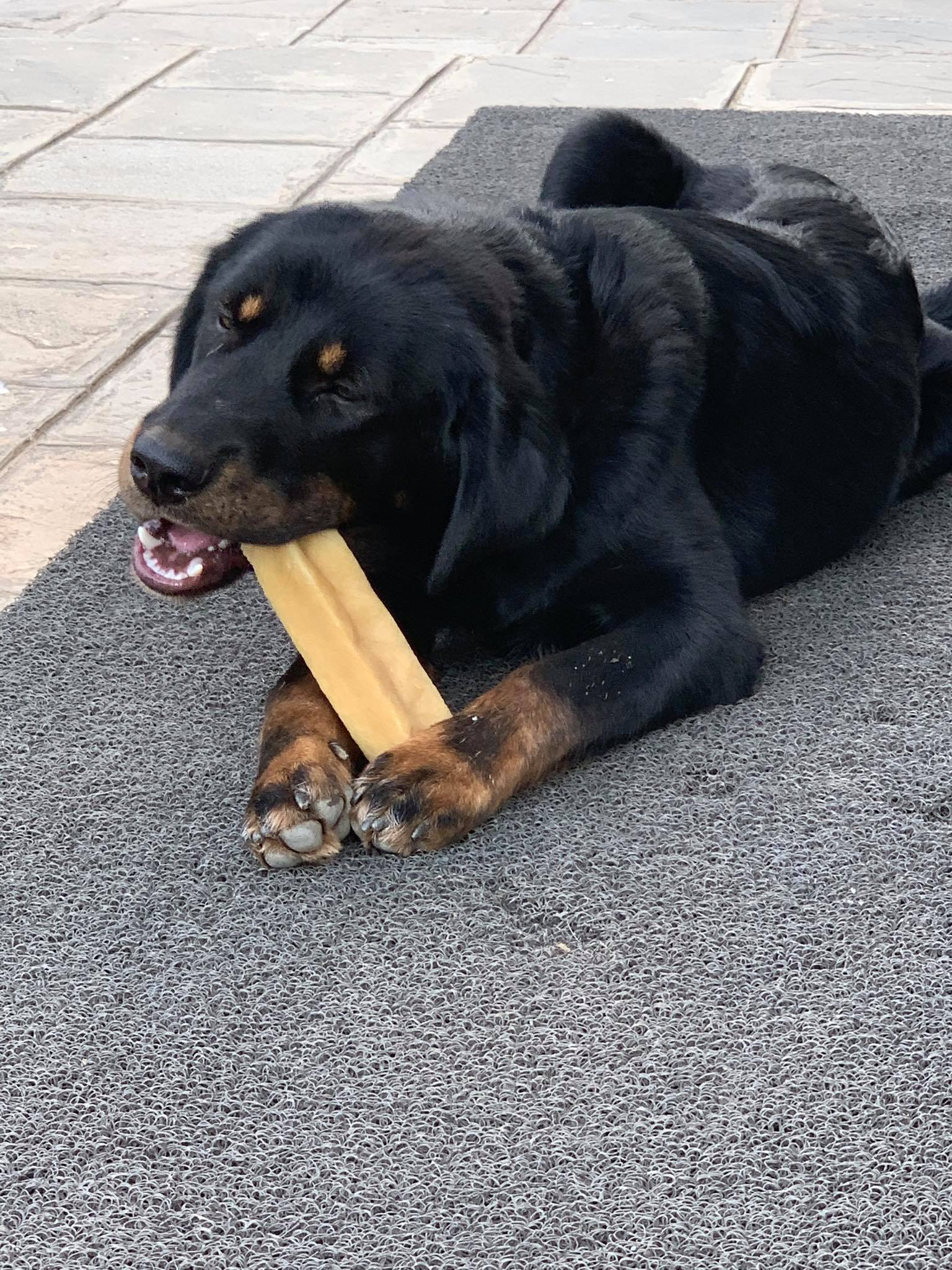Best Dog Bones for Chewing 2025
Essential Safety Guidelines for Dog Bones
Every veterinarian has stories about emergency surgeries to remove bone fragments from dogs' intestinal tracts. According to veterinary emergency clinics, bone-related obstructions and perforations rank among the most common preventable injuries in dogs.
While dogs have chewed bones for thousands of years, modern pet ownership requires understanding the difference between safe and dangerous bone options. The wrong choice can result in expensive emergency surgery or worse.
Complete Dog Bone Safety Guide
Raw vs Cooked Bones: The Life-or-Death Difference
The cooking process fundamentally changes bone structure in ways that create serious hazards for dogs. Raw bones remain flexible and digestible, while cooked bones become brittle and dangerous.
Never Give Cooked Bones
Cooked bones splinter into sharp fragments that can perforate the esophagus, stomach, or intestines. This includes bones from your dinner table, smoked bones, and any commercially processed cooked bones. The cooking process removes moisture and changes the bone matrix, making splintering inevitable.
Why Raw Bones Are Different
Raw bones retain moisture and flexibility that allow them to compress under pressure rather than shatter. The natural enzymes and minerals remain intact, providing nutritional benefits while satisfying chewing instincts.
Raw beef bones from grass-fed cattle provide the safest option for most dogs. The size and density work well for medium to large breeds when properly selected.
Raw chicken bones are safe only for small dogs and must be fresh. Older chicken bones become more brittle even when raw.
Raw lamb bones offer good density for powerful chewers but require careful sizing to prevent swallowing.
Critical Sizing Guidelines That Prevent Emergencies
Bone size relative to your dog determines safety more than bone type. Veterinary emergency rooms see more injuries from appropriately-typed but incorrectly-sized bones than from clearly inappropriate choices.
| Dog Weight | Minimum Bone Length | Recommended Bone Types | Bones to Avoid |
|---|---|---|---|
| Under 25 lbs | 4-6 inches | Chicken necks, small beef ribs | Large marrow bones, weight-bearing bones |
| 25-50 lbs | 6-8 inches | Beef ribs, lamb shanks | Chicken leg bones, small rib bones |
| 50-100 lbs | 8-12 inches | Large beef knuckle bones, femur sections | Poultry bones, thin rib bones |
| Over 100 lbs | 12+ inches | Beef femur, large knuckle bones | Any bone shorter than dog's muzzle |
The Swallowing Test
Before giving any bone, ensure it's too large to fit entirely in your dog's mouth. If the dog can get the whole bone past their molars, it's too small and poses a choking or obstruction risk.
Safe Bone Types and Sourcing Guidelines
Not all raw bones provide equal safety or nutritional value. Source quality and bone selection significantly impact both safety and digestibility.
Weight-Bearing vs Non-Weight-Bearing Bones
Non-weight-bearing bones (ribs, necks, tails) remain softer and more digestible. These work well for most dogs and provide easier chewing with lower tooth damage risk.
Weight-bearing bones (leg bones, femurs) are harder and more durable but can damage teeth in aggressive chewers. Reserve these for dogs who destroy softer bones too quickly.
Sourcing and Storage Requirements
Raw bones require the same food safety protocols as raw meat for human consumption. Purchase from reputable butchers or pet stores that maintain proper refrigeration and rotation.
Fresh bones should be used within 3-4 days of purchase when refrigerated. Frozen bones can last several months but should be thawed completely before offering.
Avoid pre-packaged bones with unknown age or storage history. These may have bacterial contamination or structural changes that increase risk.
Emergency Warning Signs Every Owner Must Know
Bone-related emergencies develop rapidly. Recognizing early symptoms can mean the difference between outpatient treatment and major surgery.
Immediate Emergency Symptoms
- Excessive drooling with blood streaks
- Pawing at mouth or throat
- Difficulty swallowing or breathing
- Retching without producing vomit
- Collapse or loss of consciousness
These symptoms require immediate veterinary attention. Do not wait or attempt home remedies.
Delayed Obstruction Symptoms
Intestinal obstructions from bone fragments may not appear for hours or days after consumption:
- Loss of appetite lasting more than 24 hours
- Vomiting, especially if persistent
- Straining to defecate or producing no stool
- Lethargy and reluctance to move
- Abdominal distension or pain when touched
Safer Chewing Alternatives to Natural Bones
Many dog owners seek bone alternatives that provide chewing satisfaction without the inherent risks. Several options offer comparable benefits with improved safety profiles.
VOHC-Approved Dental Chews
The Veterinary Oral Health Council approves specific products that provide both chewing satisfaction and dental benefits without the risks associated with natural bones.
Products like Greenies dental treats undergo clinical testing to demonstrate plaque reduction while providing safe chewing experiences. These engineered chews dissolve safely during digestion while satisfying natural chewing instincts.
Benefits of Professional Dental Chews
- Consistent quality and safety testing
- Appropriate sizing for all dog breeds
- Digestible materials that don't cause obstructions
- Proven dental health benefits
- No sharp fragments or splintering risk
- Convenient storage without refrigeration
For dogs who need the satisfaction of longer chewing sessions, consider rotating between different safe alternatives rather than relying solely on natural bones.
See Our Complete Dental Chew Safety GuideSupervision Requirements and Time Limits
No bone is safe for unsupervised chewing, regardless of type or size. Supervision allows immediate intervention if problems develop.
Active Supervision Guidelines
Stay within immediate reach while your dog chews. This means close enough to intervene within seconds, not just in the same room.
Set time limits based on your dog's chewing style. Most dogs should have bones removed after 15-20 minutes to prevent excessive wear or consumption of small fragments.
Monitor bone condition throughout the session. Remove bones that develop sharp edges, splinter, or become small enough to swallow.
When to Remove Bones Immediately
Certain conditions require immediate bone removal to prevent injuries:
- Bone becomes small enough to fit entirely in dog's mouth
- Sharp edges or splinters develop
- Dog attempts to bury or hide the bone
- Multiple dogs show interest in the same bone
- Dog exhibits resource guarding behaviors
- Bone develops bacterial smell or slimy texture
Frequently Asked Questions About Dog Bone Safety
Rawhide poses significant choking and obstruction risks. Many dogs can tear off large pieces that swell in the stomach, creating blockages requiring surgical removal. Quality varies dramatically between manufacturers, with some using harmful chemicals in processing.
Fresh bones from reputable butcher sections are generally safe if properly sized and supervised. Avoid pre-packaged bones with unknown storage history or bones that have been sitting under heat lamps.
Most veterinarians recommend limiting natural bones to 1-2 times per week for healthy dogs. More frequent bone consumption can cause digestive upset or tooth damage from excessive chewing.
Contact your veterinarian immediately. Small fragments may pass naturally, but professional evaluation is essential. Never induce vomiting unless specifically instructed by a veterinarian, as this can cause additional injuries.
Processing methods like smoking or dehydrating change bone structure similarly to cooking, making them more brittle and prone to splintering. These products carry similar risks to fully cooked bones.
Affiliate Disclosure: ThePetProductLab participates in affiliate programs including Amazon Associates. We may earn commissions on qualifying purchases made through our links at no extra cost to you.


